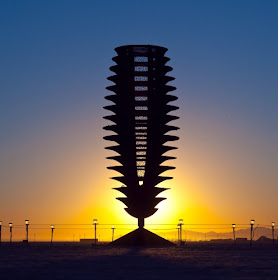Citizen Architect: Samuel Mockbee and the Spirit of the Rural Studio is a documentary film on the late architect Samuel Mockbee and the radical educational design/build program known as the Rural Studio.
Pier Luigi Nervi, Italian engineer
Pier Luigi Nervi (June 21, 1891 – January 9, 1979) studied at the University of Bologna and qualified in 1913. Dr. Nervi taught as a professor of engineering at Rome University from 1946-61. He is widely known as a structural engineer and an architect, and for his innovative use of reinforced concrete. Archeological excavation suggests he may have broken the law building the Via Flamiania stadium by laying foundations through ancient Roman tombs.
Oscar Niemeyer - Brazilian Modernist
During a career that spanned seventy-five years, architect Oscar Niemeyer defined modern architecture in Brazil. futuristic, elegant, flowing, iconic buildings

Ryue Nishizawa, SANAA
Japanese architect Ryue Nishizawa is best known for his collaborative works with architect Kazuyo Sejima. Their firm, Sejima + Nishizawa and Associates (SANAA), is praised for designing powerful, minimalist buildings using common, everyday materials.
Jean Nouvel, Architect of Light and Shadow
French architect Jean Nouvel designs flamboyant and colorful buildings that defy classification. Other-worldly luminosity, classy elegance.

Frederick Law Olmsted, Father of American Landscape Design
Frederick Law Olmsted was a landscape architect before the profession was founded. He was a visionary who foresaw the need for national parks, devised one of America's first regional plans, and designed America's first large suburban community.
Ieoh Ming Pei, Pritzker Prize Laureate
I.M. Pei is known for using large, abstract forms and sharp, geometric designs. His glass-clad structures seem to spring from the high tech modernist movement. However, Pei is more concerned with function than theory. His works often incorporate traditional Chinese symbols and building traditions. Classic, timeless and yet still iconic and futuristic, beautiful geometry-inspired buildings.
Cesar Pelli, Creator of the Petronas Towers
Cesar Pelli is often praised for using a wide variety of materials and designs, seeking new solutions for each location. Believing that buildings should be "responsible citizens," Cesar Pelli strives to design buildings that work within the surrounding city.
Renzo Piano, Pritzker Prize-Winning Architect
Renzo Piano was born into a family of builders. His grandfather, father, four uncles, and brother were contractors. Renzo Piano payed honor to this tradition when he named his architecture firm Renzo Piano Building Workshop.
Richard Rogers, Modern “High Tech” Architect
British architect Richard Rogers has designed some of the most important buildings of the modern era.
Born July 23rd, 1933 in Florence, Italy, Richard Rogers' father studied medicine and hoped that Richard would pursue a career in dentistry. Richard's mother was interested in modern design and encouraged her son's interest in the visual arts. A cousin, Ernesto Rogers, was one of Italy's prominent architects. As war broke out in Europe, the Rogers family moved back to England where Richard Rogers attended public schools. He was dyslexic and did not do well. Rogers had a run in with the law, entered the National Service, became inspired by the work of his relative, Ernesto Rogers, and ultimately decided to enter London's Architectural Association school.

Eero Saarinen, Finnish-American Architect
Whether designing furniture, airports, or grand monuments, Eero Saarinen was famous for innovative, sculptural forms. Born in 1910, were it not for Eero's untimely death during surgery in 1961, it is likely that he would have had an even bigger impact on architecture had he lived longer and worked more.
Eero Saarinen's father, Eliel Saarinen, was a prominent architect also. In 1923, when Eero was 13, the family moved to the United States. Eliel Saarinen became the first president of the Cranbrook Academy of Art in Michigan, where he also taught. Eero Saarinen studied under his father and befriended fellow students Charles and Ray Eames.

Rudolf Schindler, Pioneering Modern Architect
Rudolph Michael Schindler (born Rudolf Michael Schindler, 1887–1953) was an Austrian who emigrated to the United States. His most important works, mostly private houses, were built in or near Los Angeles during the early to mid-twentieth century. Although he worked and trained with some of its foremost practitioners, he often is associated with the fringes of the modern movement in architecture. His inventive use of complex three-dimensional forms, warm materials, and striking colors, as well as his ability to work successfully within tight budgets, however, have placed him as one of the true mavericks of early twentieth century architecture. Mostly, his work escaped widespread publication during his lifetime, but has developed a critical resurgence since the 1980s.
Kazuyo Sejima, SANAA
Japanese architect Kazuyo Sejima is best known for her collaborative projects with architect Ryue Nishizawa. Their firm, Sejima + Nishizawa and Associates (SANAA), is praised for designing powerful, minimalist buildings using common, everyday materials. Kazuyo Sejima and Ryue Nishizawa share the 2010 Pritzker Architecture Prize. Sejima and Nishizawa also maintain separate practices, which usually focus on smaller commissions.
Robert Siegel, Modern Architect
With Charles Gwathmey, Robert Siegel is a partner in the New York firm Gwathmey Siegel & Associates. The partnership was formed in 1968.
Snohetta Architects
Craig Dykers and Kjetil T. Thorsen

Louis Sullivan, early American Modernism
Jørn Utzon Architect of Sydney Opera House
Donald Wexler, Palm Springs, low-rise Modernist
Sir Clough Williams-Ellis, Architect and Environmentalist
Designer of Portmeirion
Paul Revere Williams, Hollywood Architect
Paul Williams became famous for his role in designing the Los Angeles International Airportand over 2000 homes in Southern California. Many of the most beautiful houses in Hollywood were designed by Paul Williams.
Frank Lloyd Wright, America's Legendary Architect
20th Century architectural trailblazer defined his era with his inspiring, leading-edge buildings.

Source: About.com Architecture Guide by Jackie Craven














































